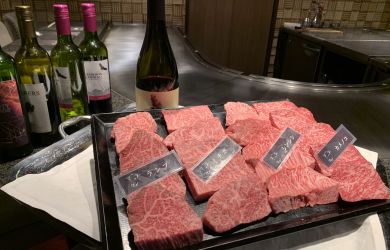
January 22, 2009
Screen Dreams
A digital-age literary form has become a publishing powerhouse
By Metropolis
Originally published on metropolis.co.jp on January 2009

Illustration by Phil Couzens
In her living room in Hokkaido, a young woman sits punching the keys of her keitai. The voices of those around her don’t seem to break her concentration. Like other girls text messaging, surfing the internet and gaming, “kiki”* is as skilled as she is serious with her keitai. But unlike them, she just happens to be writing a novel.
“I started reading keitai shosetsu (cellphone novels) last year, and writing this year,” she told Metropolis in a recent interview.
“They are easy to read and write, so it was easy to get into.”
The 24-year-old housekeeper casually entered the competition for the Japan Keitai Novel Award in October 2008—and won. Along with the Grand Prize honors came ¥2 million cash and a deal with Tokyo-based Starts Publishing to print her novel, I, Girlfriend, in traditional book form. By starting each sentence on a new line, kiki captured the choppy conversational rhythm of keitai-using Japanese teens in a way traditional literature has not. Literary critic Genichiro Takahashi calls the work “the first masterpiece of the keitai novel genre.”
With keitai sites buzzing with talented amateur writers such as kiki, the publishing industry is heralding the coming of a new demographic of young authors and readers who might change the industry the way kiki challenges the conventional novel. At the same time, parents and critics are concerned that these works, with their substandard grammar and focus on violence and sex, might be a bad influence on the young women and grade school girls that are their many dedicated readers.
The appearance of keitai shosetsu has a lot to do with the prevalence of affordable, high-quality personal communication devices. Almost every adult has a keitai, and many have one apiece for work and private. According to a recent government report, 31.3 percent of elementary school students and 57.6 percent of middle school students have keitai. Research firm Net Asia adds that as many as 22.3 percent self-identify as keitai addicts.
Talking on the phone in many contexts is frowned upon, so people tend to make use of text messaging and emoticons to have lively conversations. This is cheaper than phone service, and especially pronounced among the young. A single message can be 10,000 characters long—enough to pour out a novel’s worth of angst, if one is so inclined.
“Teenage girls began messaging with pagers in the early ’90s,” says Mizuko Ito, a research scientist who studies keitai use among Japanese youth. “Because of this, Japan was the first country to have widespread mobile communications, even before mobile phones became affordable and popular.” Ito sees in the rise of keitai novels a high degree of media and gadget literacy, a cultural willingness to experiment with new technologies, and a desire for private space and intimate communication.
The way it works is this: keitai novels are posted by members of cellphone community sites to be downloaded for free and read on other keitai. Reading often takes place in crowded trains during long commutes. The works are published in 70-word installments, or abbreviated chapters that are the ideal length to be read between shorter train stops. This means that, despite small keitai screens, lots of white space is left for ease of reading. Multiple short lines of compressed sentences, mostly composed of fragmentary dialogue, are strung together with lots of keitai-only symbols. The resulting works are emotional, fast-paced and highly visual, with an impact not unlike manga.
Japan’s first cellphone novel was keyed in by “Yoshi,” whose Deep Love: Ayu’s Story (2002) details the struggles of a teenage prostitute in Tokyo. This work—like most—is romance peppered with scenes of rape, pregnancy, abortion, suicide attempts and drug addiction.

First annual Japan Keitai Novel Award Winner "Towa"
Promoted by avid readers online, Deep Love became a grassroots sensation and was picked up by Starts Publishing and made into a printed book. Starts maintained the left-to-right keitai novel style and the emoticons, which has become now the standard in paper versions of the works. By early 2007, Deep Love had sold about 2.7 million copies and spawned a TV series, movie and manga.
The book also sparked a renaissance among keitai users with time and creativity to spare. When another author, “Chaco,” appeared with What an Angel Gave Me, the editors at Starts had a eureka moment.
“We got a phone call from an anonymous fan, crying, and telling us there was this great novel that we have to publish,” says Shigeru Matsushima, 43, a producer at Starts. “We had thought that keitai novels meant ‘Yoshi,’ but then our eyes were opened to all these other writers doing great work and all these communities passionately supporting them.”
Following Starts, other publishers like Goma and Asuki Media Works moved in to cherry pick cellphone novel sites online and put out the Next Big Hit. The number of keitai shosetsu in print began skyrocketing in 2006, when 22 books hit the shelves; the following year, there were 98. Even a no-name author with a cellphone novel publishing deal enjoyed a first run of between 50,000 and 100,000 copies.
The popularity of the genre is spreading beyond young girls. Ten of the bestselling printed novels in Japan in 2007 were based on keitai shosetsu, and each sold around 400,000 copies. Strikingly, the sales were strongest for costly hardcovers, which readers who had already experienced the work on their keitai screens bought as memorials. Starts alone has released 40 titles that have sold 10 million copies.
Matsushima stresses that keitai shosetsu proved that there was a market for females between the ages of 10 and 20, a demographic thought to be apathetic towards reading. According to a recent Mainichi Shinbum newspaper survey, 86 percent of high school, 75 percent of middle school and 23 percent of grade school girls read cellphone novels.
But the novelty of keitai shosetsu is turning out to be a hard sell among many adults. On the one hand, the novels are praised for inspiring youngsters to take an active interest in reading and writing; on the other, they’re criticized for a lack of diverse vocabulary and a general dumbing-down of traditional literary approaches.
Indeed, keitai novels do not go through the editorial selection process; they first become popular with readers and then are published based on their ability to please a crowd. This rawness is at once their appeal and a major hurdle keeping the emergent genre from maturing.
For their part, media-savvy otaku are getting a kick out of keitai novels—by piling on merciless lampoons and viciously critical rants. Regarding the enormously popular Koizora, for example, they point out that the self-styled “true story” has a character in the advanced stages of cancer who fathers a child, the mother of whom miscarries after being pushed down by a female bully.
These plot points are stretches, to say the least, and move to the realm of the comical when combined with grammar and vocabulary below the high school average.
Online detractors call keitai novel enthusiasts yutori, slang for those who cannot properly read, write or think because of the “slow education” (yutori kyouiku) system adopted in the ’90s to reduce pressure on kids.
Then there is the elephant in the room—sexual and violent material targeting kids. One grade school teacher wrote a scathing review of Koizora (2005), calling it a “crime of the media” and suggesting that the story—which involves a young girl in a tumultuous relationship with a juvenile delinquent—has induced some 12-year-olds to fantasize about being raped by a man who then falls in love with them. The Koizora film, stars Yui Aragaki, a favorite actress among prepubescent Japanese girls. Similarly, the 2007 film Clearness, based on the award-winning keitai novel by “Towa,” tells of romance between a high school-aged prostitute and a host-club gigolo.
Many parents are also concerned about the sorts of relationships being fostered on keitai shosetsu community sites. In late 2008, cellphone novelist Misako Yokomori, 35, was arrested for arranging an “off” (offline) meeting with and fondling a 16-year-old female fan.
This backlash against female fan fiction is not without precedent. Shojo novels, amateur writings published in girls magazines in the early 1900s, were also criticized as deviant, inane and encouraging inappropriate affection among (and with) girls. These works, however, grew so popular that they attracted contributions by the likes of Nobel Prize laureate Kawabata Yasunari. Similarly, Jakucho Setouchi, a Buddhist nun who translated the The Tale of Genji into modern Japanese, has revealed that she has written keitai shosetsu.
By Matsushima’s estimation, the genre underwent growing pains during its nascent boom years, but he believes that the furor will die down.
“The era of selling a million copies of one book is over, with the rising number of writers and the shrinking number of youth in Japan,” he says. “However, this is a very sturdy industry that will continue to mature and grow.”
Not everyone is so sure.
“I think Japanese readers, publishers and society wish for keitai shosetsu to have more impact than they do,” said Yonnie Kim, 37, a researcher at the University of Tokyo who has studied the cellphone novel phenomenon. “The point is, how long it will last.”
For her part, kiki doesn’t seem interested in the long term anyway.
“I really haven’t thought about what to do from now,” she says.
“If people think for a second that my free-writing in keitai novels is interesting, that is enough. I want to keep on writing like that.”
For more info on keitai shosetsu, check out Magic Island and Gocco.





